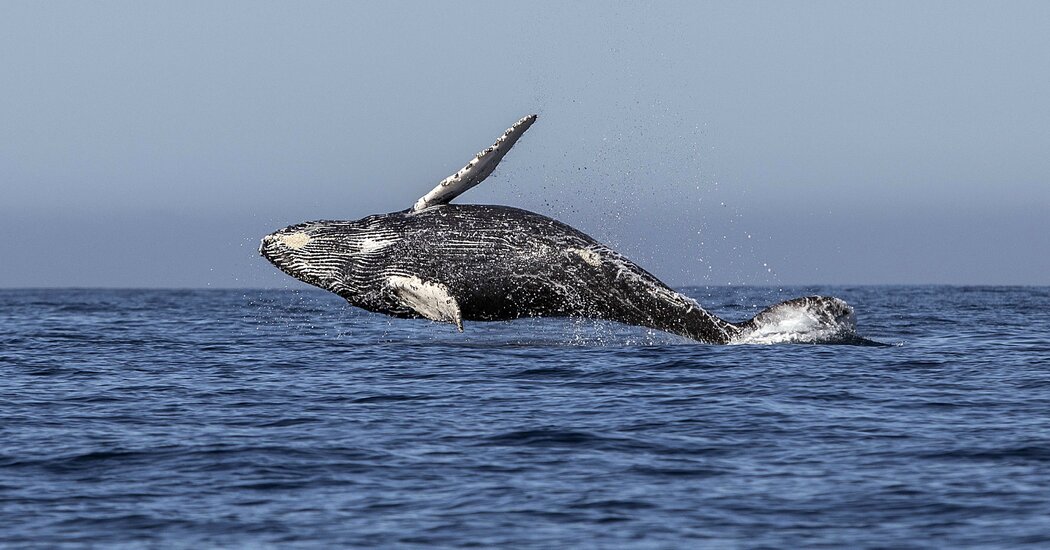The opening of California’s commercial crab season, which normally starts in November, is delayed once again to protect humpback whales foraging for krill and anchovies along the coast.
This region of the Pacific has been under the grip of a marine heat wave since May. “The Blob,” as this mass of warm water has become known, is squeezing cooler water preferred by whales and their prey close to shore, where fishermen set their traps.
This crowding can lead to literal tangles between whales and fishing equipment, endangering the animals’ lives and requiring grueling rescue missions.
In a new study, scientists say they can now use global temperature models, commonly used in climate science, to predict up to a year in advance when hot ocean temperatures raise the risk of whale entanglements. This lead time could allow state regulators, fishermen, and other businesses that depend on the fishery — as well as Californians hoping for a Dungeness crab holiday meal — to plan ahead for potential fishing restrictions.
“It really just helps give a lot more information and reduce some of that uncertainty about the future,” said Steph Brodie, lead author of the study published Tuesday in the journal Nature Communications. Dr. Brodie is currently a research scientist at Australia’s national science agency, but conducted this research while working at the University of California Santa Cruz and the National Oceanographic and Atmospheric Administration.
The tool analyzed in the new study, called the Habitat Compression Index, works by feeding sea-surface temperature measurements into an equation that estimates the likelihood of whale habitat shrinking closer to shore. Previously, the index analyzed only recent conditions, using data from the previous month.
But sea-surface temperatures themselves can be predicted accurately months in advance. According to the new study, the Habitat Compression Index can use these temperature forecasts to predict humpback whales’ locations up to 11.5 months into the future. The index was most accurate at forecasts for the winter and spring.
The scientists also studied loggerhead sea turtles, which visit the Southern California coast during unusually warm years and sometimes get caught in swordfish drift gillnets, and found they could similarly predict the turtles’ movements months in advance.
California isn’t the only place scientists could make animal forecasts. Dr. Brodie and her colleagues are on a mission to extend advances in satellite observations, physical oceanography and climate science to the realms of ecology and natural resource management worldwide. They call this emerging field “ecological forecasting.”
“That’s one of the exciting things about this research, is that it’s easy to replicate anywhere else,” said Jarrod Santora, an ecosystem scientist at NOAA and another author of the study. “It’s not really difficult math. Sea surface temperature is widely available.”
Ecological forecasts could help New England and maritime Canada, where highly endangered right whales are also getting entangled in fishing gear. Only about 350 individual right whales are estimated to remain.
The outlook is much brighter for humpback whales, whose population has been recovering in the decades since the end of commercial whaling. From early spring to late fall each year, thousands of humpbacks converge on Northern California and Oregon. They come from balmy winter nurseries in Mexico and Central America, traveling north to find food.
These whales are increasingly sharing territory with California’s fleet of approximately 400 commercial crab boats, which normally cruise the coast from mid-November to mid-July. The California fishery landed about 21 million pounds of crabs last year, worth just under $55 million, according to NOAA officials.
Regulators and fishermen agree that the new forecasting research could help them walk the tightrope between protecting whales and protecting local livelihoods.
“My personal opinion is that this is very, very helpful,” said Richard Ogg, a commercial fishing boat captain based in Bodega Bay.
Mr. Ogg describes himself as a staunch conservationist who doesn’t want to see whales harmed. Fishermen have a big incentive to protect the natural environment, he said, because that’s where they make their living. The challenge is adapting to changing conditions and fishing regulations on short notice, especially for smaller business owners and their crews.
“One of the biggest problems we have is the unpredictability,” Mr. Ogg said. “We’re living from week to week.”
2014-16 were particularly hot, bad years. In 2016, a record 19 humpback whales were found entangled in crab gear off California’s coast. Since then, the state has started a dedicated management program that modifies the crab season according to environmental conditions, and has gotten whale entanglements down to about three or four per year.
Though scientists have shown the Habitat Compression Index can now forecast months in advance, state officials would probably wait to see conditions in real time before making decisions about the crab fishery, said Ryan Bartling, an environmental scientist at the California Department of Fish and Wildlife. But the Dungeness Crab Fishing Gear Working Group, which includes both Mr. Ogg and Dr. Santora, meets monthly with officials and the forecasts could inform their discussions and planning throughout the year, Mr. Bartling said.
The study also analyzed a similar tool for loggerhead sea turtles created by co-author Heather Welch. It was more accurate at forecasting than the whale tool, but it was applied only to the summer months.
In 2022, Congress passed federal legislation to phase out the drift gillnets that catch loggerheads. While the turtle tool isn’t currently used for regulation, officials still use it to inform their decisions and communicate with fishermen, said Amber Rhodes, a fishery policy analyst with NOAA.
As the climate changes, many marine species are on the move. Some may move away from active fisheries, while others — like humpback whales — might move closer. “Often we don’t know how it will shake out,” Ms. Rhodes said. Forecasts that give regulators and industry lead time and flexibility will help fisheries adapt and be resilient, she said. “That’s the true need in a fluid environment like the ocean.”
#Whale #Forecast #Fishermen



